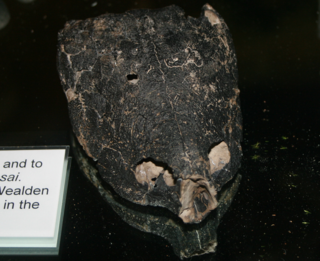Related Research Articles

Osteolepididae is a family of primitive, fish-like tetrapodomorphs that lived during the Devonian period. The family is generally thought to be paraphyletic, with the traits that characterise the family being widely distributed among basal tetrapodomorphs and other osteichthyans. Some of genera historically placed in Osteolepididae have more recently been assigned to the family Megalichthyidae, which appears to be a monophyletic group.
The North American land mammal ages (NALMA) establishes a geologic timescale for North American fauna beginning during the Late Cretaceous and continuing through to the present. These periods are referred to as ages or intervals and were established using geographic place names where fossil materials were obtained.

The Barstovian North American Stage on the geologic timescale is the North American faunal stage according to the North American Land Mammal Ages chronology (NALMA), typically set from 16,300,000 to 13,600,000 years BP, a period of 2.7 million years. It is usually considered to overlap the Langhian and Serravallian stages of the Middle Miocene. The Barstovian is preceded by the Hemingfordian and followed by the Clarendonian NALMA stages.

The Itaboraian age is a period within the Early Eocene geologic time epoch of the Paleogene, used more specifically with South American land mammal ages (SALMA). It follows the Riochican and precedes the Casamayoran age.
The Deseadan age is a period of geologic time within the Oligocene epoch of the Paleogene to the Early Miocene epoch of the Neogene, used more specifically within the SALMA classification of South America. It follows the Tinguirirican and precedes the Colhuehuapian age.
The Laventan age is a period of geologic time within the Middle Miocene epoch of the Neogene, used more specifically within the SALMA classification in South America. It follows the Colloncuran and precedes the Mayoan age.

Genevievella is a genus of trilobites with a short inverted egg-shaped outline, a wide headshield, small eyes, and long genal spines. The backrim of the headshield is inflated and overhangs the first of the 9 thorax segments. The 8th thorax segment from the front bears a backward directed spine that reaches beyond the back end of the exoskeleton. It has an almost oval tailshield with 5 pairs of pleural furrows. It lived during the Upper Cambrian in what are today Canada and the United States.
Phlaocyon minor is an extinct species of canid mammal known from the Miocene-Oligocene of the United States

Gigantostrea is an extinct genus of marine bivalve mollusks belonging to the family Gryphaeidae.

Neopycnodonte cochlear is a species of marine bivalve molluscs belonging to the family Gryphaeidae.

Helochelydra is an extinct genus of extinct stem turtle known from the Early Cretaceous (Barremian) of the Isle of Wight, southern England.

Miocochilius is an extinct genus of small notoungulate mammals (typotheres) native to South America. The genus lived during the Middle Miocene epoch. The genus contains two described species, the type species M. anomopodus described in 1953 by Ruben Arthur Stirton and M. federicoi, described and included in the genus by Darin A. Croft.
Canaanimico is an extinct genus of medium-sized New World monkeys from the Late Oligocene fossiliferous fluvio-lacustrine Chambira Formation of the Ucayali Basin in Amazonian Peru. The genus was described by Marivaux et al. in 2016 and the type species is C. amazonensis.

Helohyidae were a group of artiodactyl mammals. They were most prominent in the mid-to-upper Eocene.

Sphodrosaurus is an extinct genus of basal archosauriformn reptiles from the Late Triassic-aged New Oxford Formation of Pennsylvania. The type species is S. pennsylvanicus, described by Edwin Colbert in 1960. The holotype consists of a partial skeleton including the back of the skull, the vertebral column, all of the ribs, all of the hindlimbs and part of the upper forelimbs; Sphodrosaurus was originally believed to have been a member of the Procolophonidae while more recently Sphodrosaurus was believed to be a basal member of the Diapsida by most authors starting with Sues et al. (1993), or a member of the Rhynchosauria. In 2022, Ezcurra & Sues redescribed the holotype in detail and placed it in a phylogenetic analysis with other Triassic diapsid reptiles, where it was found as the basalmost doswellid.

Thanatosdrakon is a genus of quetzalcoatline azhdarchid pterosaur from the Late Cretaceous Plottier Formation of the Neuquén Basin in western Argentina. The genus name is derived from the Greek words thanatos (=death) and drakon (=dragon), while the specific name is a Quechuan word meaning "flying serpent" and refers to the Incan deity Amaru. The type and only species is Thanatosdrakon amaru, known from two specimens consisting of several well-preserved axial and appendicular bones including material previously undescribed in giant azhdarchids. Thanatosdrakon is one of the oldest known members of the Quetzalcoatlinae. T. amaru lived from about 90 to 86 million years ago.
References
- ↑ Lebedev, Oleg A.; Lukševičs, Ervins (2017-09-01). "Glyptopomus bystrowi (Gross, 1941), an "osteolepidid" tetrapodomorph from the Upper Famennian (Upper Devonian) of Latvia and Central Russia". Palaeobiodiversity and Palaeoenvironments. 97 (3): 615–632. Bibcode:2017PdPe...97..615L. doi:10.1007/s12549-016-0249-9. ISSN 1867-1608. S2CID 131865318.
- ↑ "Fossilworks: Glyptopomus". fossilworks.org. Retrieved 17 December 2021.






